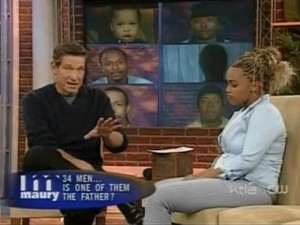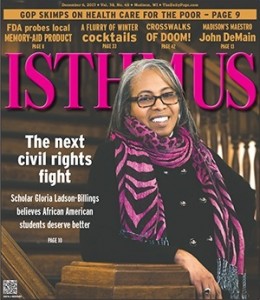Critical Race Theory & Cultural Studies — Departing from the Counternarrative
Imani Perry, Professor, Center for African American Studies at Princeton University, discusses the methods used in cultural studies and Critical Race Theory (CRT) in her article Cultural Studies Critical Race Theory and Some Reflections on Methods (2005).
Perry recognizes that while the conventional narrative approach to exploring and critiquing the relationship between law and race are a key components of CRT, cultural studies provides a methodology that uses “social practices and forms of consumption (television, church, film, games) as they relate to the structural power of law, and the underlying ideologies of constitutional and private law” (917). She argues that it is social practices such as the consumption television of talk shows she calls “paternity test shows” that create and reinforce stereotypes about race (917). Rather than disdain the “low brow” appeal of pop culture, Perry argues that artifacts of cultural production

Talk show host, Maury Povich, frequently hosts young, impoverished women of color seeking to establish paternity of their children.
should be read as a series of interdependent texts that communicate values that influence, and are influenced by, law (917).
While Perry may seem to be advocating a departure from the narrative approach of CRT, she only approaches the narrative from a different framework. In fact, she states that continued viewing of the absurd hypersexuality and promiscuity on display in the “paternity shows,” creates a narrative that is not only reified in stereotypes at large, but influences family law in which the stereotypes shape the decisions of judges, lawyers, and juries (918).
CRT is about the production of counter-narratives to oppose false pictures and stereotypes created by the dominant power structure that thrives on institutionalized racism. Counternarratives have been critiqued as ineffective to combat systemic inequality and scholars like Perry have posited new ways to approach CRT. Yet, the methodological approaches to CRT I have so far encountered seem to return to its narrative origins – it is only the lens through which the narrative is created and consumed that changes.
Perry’s discussion about family law and the influence of negative stereotypes reminds me of Dr. Mario L. Barnes’ article “Black Women’s Stories and Criminal Law.” Barnes, Professor of Law at University of California, Irvine and Co-Director of the Center for Law, Equality, and Race, writes that black women’s interactions with the criminal justice system revealed that “social and legal constructions of black women’s identities”(945) resulted in stereotypes and prejudices that undermine[d] not only individuality of the women, but also the court proceedings (950). This article, like the one summarized below, demonstrates the overlapping application of CRT to a wide variety of academic disciplines.
A question that emerged from this reading pertains to the participation of African Americans in the stereotypes and cultural artifacts that serve to further oppress them. This is where CRT merges with psychology and sociology and What does it mean to be African American? and the question of who decides. I think it is apparent through CRT that power and law decides. I like the ways in which CRT attempts to move beyond that paradigm to create counternarratives.
Works Cited
Perry, Imani. “Cultural Studies, Critical Race Theory and Some Reflection on Methods.” 50 Villanova Law Review 4 (2005): 915-24. Law and Society Commons. Web. 20 Sept. 2014.
Barnes, Mario L. “Black Women’s Stories and the Criminal Law: Restating the Power of Narrative.” 39 U. C. Davis L. Rev. (2005 -2006): 941-90. Web. 05 Sept. 2014.
Critical Race Theory in Educational Scholarship
In “Evolving Role of Critical Race Theory in Educational Scholarship” Gloria Ladson-Billings gives a quick overview of some of the articles compiled for the April 2004 American Educational Research Association symposium (115). While I plan to read each of the articles submitted for the symposium, Ladson-Billings’ introductory article gives a quick overview of some of the debates in the field of CRT. I am going to give a quick review of the article most relevant to my area of study.
Ladson-Billings critiques Tara J. Yosso’s “Whose Culture Has Capital? A critical race theory discussion of community cultural wealth.” Yosso, Professor of Chicano Studies at UCLA, insists that CRT must move beyond the “black/white binaries” (116). Ladson-Billings proposes that the issue is not the binary , but how Whiteness is the standard by with all other racial and ethnic identities are categorized (116). Ladson-Billings’ opposition to extending the discussions of CRT beyond the black/white binary is unconvincing as she goes on to discuss the variety of racial categories on the 1890 census and other racial groups that have been able, at one time, to claim Whiteness. I think this is too fine a line. Whether or not their identity was in relation to Whiteness, it did move beyond the black/white binary simply because the people claiming Whiteness were able to do so because they were not Black. Although at certain times Asian Indians, Mexican Americans, and the Cherokee were able to claim Whiteness (116), it was only possible because they were not Black.
Yosso’s article was written in 2005. I’d like to find more recent work about moving beyond the binary, particularly in light of the colorblind and multicultural liberalism that has pervaded 21st century education. Kimberle Williams Crenshaw’s article, “Twenty Years of Critical Race Theory Looking Back to Move Forward” addresses the significance of multiculturalism and colorblindness in the 21st century “post-racial” discussions about race. Her critique that these “post-racial” liberalisms impede social justice and racial equality by taking race off the table for discussion (1337) can inform an analysis of the binary.
Yosso also addresses cultural capital and appropriation. In an example of a Coca-Cola commercial in which the “joke” stems from the viewer’s assumption that the Black person could not also be the Latino person, Yosso’s binary is again confirmed. The commercial was banking on assumptions of “not Black” even though there was no “White” in the picture (117) – obviously moving beyond the black/white binary.
Although this article and the symposium from which it emerged focuses on CRT in education, it demonstrates the widespread application CRT principles. Regardless of the academic discipline, the use of narrative/counternarrative and the analysis of race v. power/law are central tenets of CRT analysis. The law component may be explicit, such as an analysis of the impact specific laws or interactions with the police or judiciary. The law component may also be implicit, a silent, but present force that shapes behavior and expectations. The critiques and questions posed by Ladson-Billings are critiques that can be posed in the application of CRT to any academic discipline, and in fact have been applied by academics in support of an in opposition to CRT.
While this article doesn’t directly address how I want to use CRT in analyzing literature, it does address some of the issues with black/white and the role of CRT in education. I reviewed several English and Literature department web sites. Many of the larger universities have a Cultural Studies and Critical Race Theory division. It is evident that Critical Race Theory has become its own discipline in English Studies and in education. How and to what extent is a question that is constantly being negotiated. I know that I want to direct my career toward working in department with a recognized Critical Race, Gender, and Cultural Studies component.
Work Cited
Crenshaw, Kimberle Williams. “Twenty Years of Critical Race Theory.” 43 Connecticut Law Review 5 (2011): 1253-352. Web. 18 Sept. 2014.
Ladson-Billings, Gloria. “The Evolving Role of Critical Race Theory in Educational Scholarship.” 8 Race Ethnicity and Education 1 (2005): 115-19. Web.
Yasso, Tara J. “Whose Culture Has Capital? A Critical Race Theory Discussion of Community Cultural Wealth.” 8 Race Ethnicity and Education 1(2005): 69-91. Web. 18 Sept. 2014.

